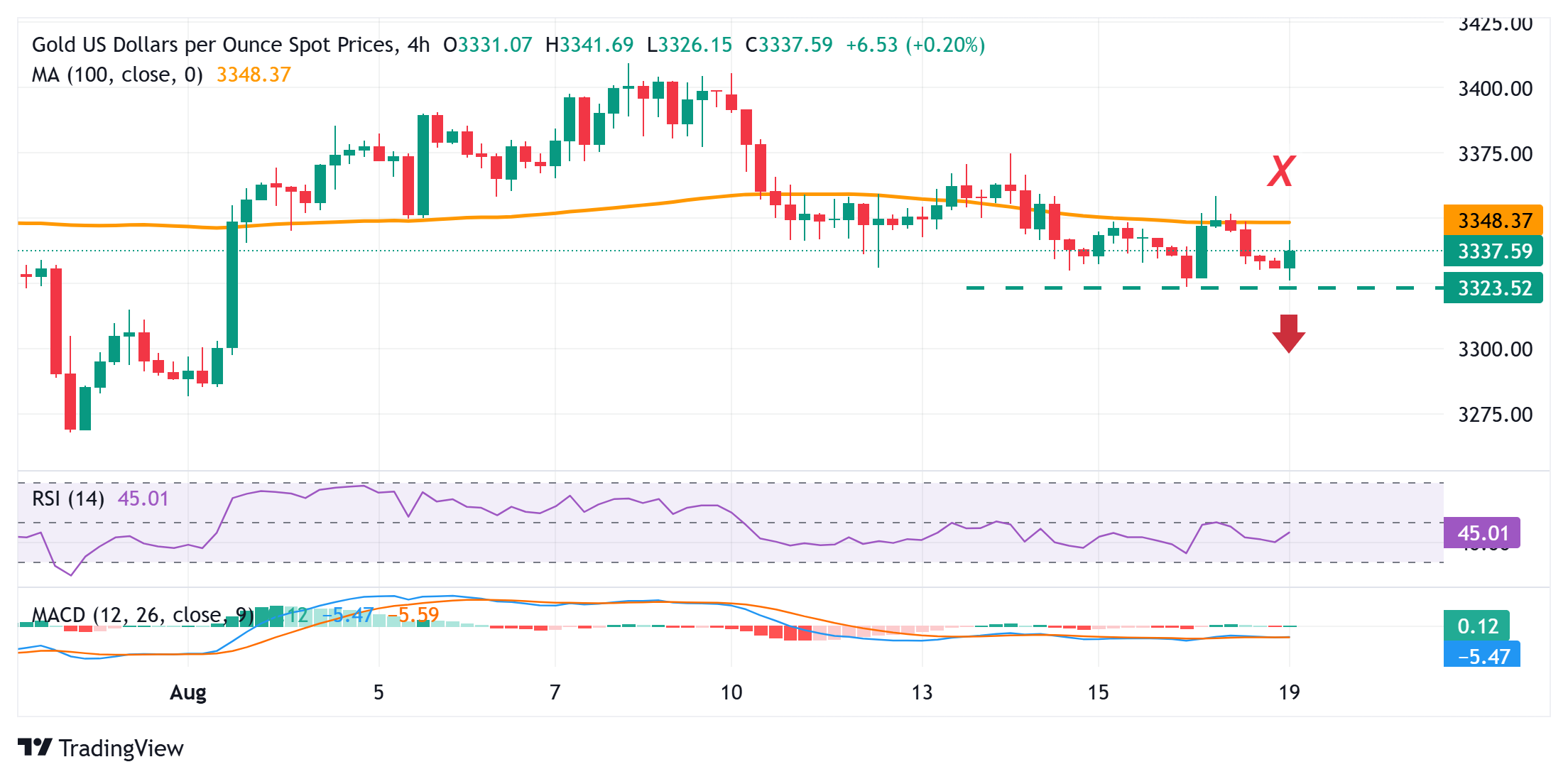Created
: 2025.08.19














![]() 2025.08.19 13:16
2025.08.19 13:16
Gold (XAU/USD) attracts some dip-buying during the Asian session on Tuesday and moves away from an over two-week low touched the previous day. The growing acceptance that the US Federal Reserve (Fed) will resume its rate-cutting cycle in September turns out to be a key factor offering some support to the non-yielding yellow metal. Apart from this, the cautious market mood drives some safe-haven flows towards the commodity.
Meanwhile, the US Dollar (USD) is looking to build on the previous day's positive move amid diminishing odds for a more aggressive policy easing by the US central bank. Apart from this, hopes for a Russia-Ukraine peace deal might contribute to capping the upside for the non-yielding Gold. The XAU/USD bulls might opt to wait for the FOMC Minutes on Wednesday and Fed Chair Jerome Powell's speech at the Jackson Hole Symposium.

Slightly negative technical indicators on 4-hour/daily charts warrant some caution for bulls or positioning for any meaningful appreciating move in the near-term. Hence, any subsequent move up is more likely to confront stiff resistance near the 200-period Simple Moving Average (SMA) on the 4-hour chart, currently pegged around the $3,347-3,348 region. This is followed by the overnight swing high, around the $3,358 area, above which the XAU/USD pair could climb to the $3,372-3,374 region. The momentum could extend further and allow the Gold price to reclaim the $3,400 mark before aiming to test the monthly peak, around the $3,408-3,410 area.
On the flip side, the $3,325-3,323 zone, or over a two-week low touched on Monday, could offer immediate support ahead of the $3,310-3,300 region. Acceptance below the said handle could make the XAU/USD pair vulnerable to accelerate the fall towards the $3,283-3,282 horizontal zone before dropping to the late June swing low, around the $3,268 region. The latter represents the lower boundary of a nearly three-month-old trading range, and a convincing break below will be seen as a fresh trigger for bearish traders.
Gold has played a key role in human's history as it has been widely used as a store of value and medium of exchange. Currently, apart from its shine and usage for jewelry, the precious metal is widely seen as a safe-haven asset, meaning that it is considered a good investment during turbulent times. Gold is also widely seen as a hedge against inflation and against depreciating currencies as it doesn't rely on any specific issuer or government.
Central banks are the biggest Gold holders. In their aim to support their currencies in turbulent times, central banks tend to diversify their reserves and buy Gold to improve the perceived strength of the economy and the currency. High Gold reserves can be a source of trust for a country's solvency. Central banks added 1,136 tonnes of Gold worth around $70 billion to their reserves in 2022, according to data from the World Gold Council. This is the highest yearly purchase since records began. Central banks from emerging economies such as China, India and Turkey are quickly increasing their Gold reserves.
Gold has an inverse correlation with the US Dollar and US Treasuries, which are both major reserve and safe-haven assets. When the Dollar depreciates, Gold tends to rise, enabling investors and central banks to diversify their assets in turbulent times. Gold is also inversely correlated with risk assets. A rally in the stock market tends to weaken Gold price, while sell-offs in riskier markets tend to favor the precious metal.
The price can move due to a wide range of factors. Geopolitical instability or fears of a deep recession can quickly make Gold price escalate due to its safe-haven status. As a yield-less asset, Gold tends to rise with lower interest rates, while higher cost of money usually weighs down on the yellow metal. Still, most moves depend on how the US Dollar (USD) behaves as the asset is priced in dollars (XAU/USD). A strong Dollar tends to keep the price of Gold controlled, whereas a weaker Dollar is likely to push Gold prices up.
![]()
Created
: 2025.08.19
![]()
Last updated
: 2025.08.19

FXStreet is a forex information website, delivering market analysis and news articles 24/7.
It features a number of articles contributed by well-known analysts, in addition to the ones by its editorial team.
Founded in 2000 by Francesc Riverola, a Spanish economist, it has grown to become a world-renowned information website.
We hope you find this article useful. Any comments or suggestions will be greatly appreciated.
We are also looking for writers with extensive experience in forex and crypto to join us.
please contact us at [email protected].
Disclaimer:
All information and content provided on this website is provided for informational purposes only and is not intended to solicit any investment. Although all efforts are made in order to ensure that the information is correct, no guarantee is provided for the accuracy of any content on this website. Any decision made shall be the responsibility of the investor and Myforex does not take any responsibility whatsoever regarding the use of any information provided herein.
The content provided on this website belongs to Myforex and, where stated, the relevant licensors. All rights are reserved by Myforex and the relevant licensors, and no content of this website, whether in full or in part, shall be copied or displayed elsewhere without the explicit written permission of the relevant copyright holder. If you wish to use any part of the content provided on this website, please ensure that you contact Myforex.
Myforex uses cookies to improve the convenience and functionality of this website. This website may include cookies not only by us but also by third parties (advertisers, log analysts, etc.) for the purpose of tracking the activities of users. Cookie policy